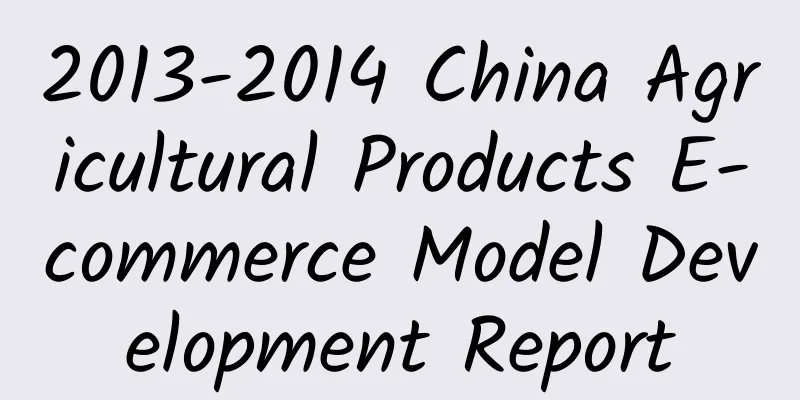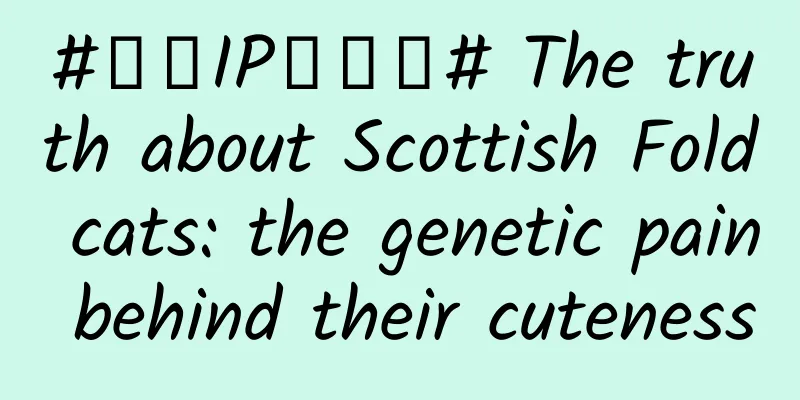2013-2014 China Agricultural Products E-commerce Model Development Report

|
The China Food (Agricultural Product) Safety E-commerce High-level Seminar was held in Beijing. The "2013-2014 Agricultural Product E-commerce Model Development Report" was released at the meeting, and the China Food (Agricultural Product) Safety E-commerce Research Institute was officially established. During the meeting, experts discussed and heatedly discussed hot issues such as my country's food (agricultural product) safety and the construction of my country's food (agricultural product) safety e-commerce demonstration parks. This meeting was jointly organized by Beijing Technology and Business University, China Food Industry Integrity Alliance, and China Safe Food E-commerce Platform. The first research result released by the China Food (Agricultural Product) Safety E-commerce Research Institute, "2013-2014 Agricultural Product E-commerce Model Development Report", has made detailed statistics, analysis and demonstration on the development background, development status and development trend of my country's agricultural product e-commerce model in the past one or two years. Hong Tao, professor of the School of Economics of Beijing Technology and Business University, specially appointed expert of the Ministry of Commerce, and expert of agricultural product market circulation of the Ministry of Agriculture, who is one of the authors of the report, gave a detailed introduction and in-depth interpretation of the content of the report. The multi-level e-commerce network system has taken shape Five characteristics of business model Hong Tao, professor at the School of Economics of Beijing Technology and Business University, pointed out that in 2013, my country initially formed a multi-level agricultural product e-commerce network system, including the agricultural government information network and the agricultural product electronic trading network. Talking about the current status of agricultural product e-commerce development, Professor Hong Tao introduced that according to first-hand statistical analysis, my country's agricultural products had a bumper harvest in 2013, with a total output of nearly 2 billion tons, and agricultural product e-commerce has developed rapidly. According to statistics, among the 31,000 agricultural websites in the country, there are more than 3,000 e-commerce websites. The operation forms of each website have five main characteristics: First, online futures trading of agricultural products. In 2013, the number of online futures trading of agricultural products reached 16, with a trading volume of 31.53 trillion yuan. Second, the electronic trading of bulk commodities includes more than 10 industries such as wine, agricultural products, forest products, animal husbandry and fishery products, etc. Among them, there are 161 online trading markets for agricultural products and 17 for wine, with a transaction volume of more than 10 trillion yuan. Third, online grain trading is very active. According to the National Bureau of Statistics, there were 111 grain trading markets with a turnover of more than 100 million yuan in 2012, with a turnover of 164.126 billion yuan. According to statistics from the National Grain Industry Association, there were 65 grain markets in the National Grain Administration system in 2013, with an online turnover of nearly 200 billion yuan. Fourth, the government information websites of the Ministry of Commerce, the Ministry of Agriculture, and the China Supply and Marketing Cooperatives include government departments that organize online production and marketing fairs. The Ministry of Commerce organizes online agricultural product fairs in summer and winter, with a transaction volume of 83.933 billion yuan. Fifth, various online retail models of agricultural products. In 2013, the e-commerce of fresh agricultural products developed rapidly, and fresh agricultural products became the fourth largest category of online hot-selling products. For example, the number of online stores registered in rural areas (including counties) on Taobao reached 2.039 million, an increase of 24.9% over the previous year, with a transaction volume of more than 50 billion yuan. The transaction volume of online retail of fresh agricultural products on JD.com exceeded 10 billion yuan. Innovative development of agricultural products e-commerce platform Mainstream models are diverse When talking about the agricultural product e-commerce platforms with great influence, Professor Hong Tao summarized and analyzed more than ten mainstream models: Electronic vegetable boxes are a model of "e-commerce + cold chain express logistics + smart terminal pickup". Electronic vegetable boxes became popular in Wuhan, Hubei in 2012. In the morning, you can click the mouse to select vegetables online, pay online, and then pick up vegetables from the vegetable box at your doorstep in the afternoon. The price of vegetables is 20% cheaper than that in supermarkets. This unmanned delivery electronic vegetable box direct sales retail method has now entered more than 240 communities in Wuhan, providing fresh food delivery to more than 3,000 families every day. Smart vegetable cabinets use B to C e-commerce platforms as carriers to build online super fresh food markets. They are a model of "direct supply from the source + e-commerce + smart containers". For example, the smart vegetable cabinets in Yangzhou, Jiangsu, use Internet of Things technology to achieve "direct access to production and sales" and "connection between farmers and houses". Smart vegetable cabinets are installed free of charge in the community, and citizens can receive clean and high-quality fresh agricultural products with just a click of the mouse or a phone call. The China Geographical Indication Product Mall is a B to B to C model and a C to B model. The mall is the first online mall in China to sell nationally certified (registered and approved) geographical indication products. The mall provides online sales services to geographical indication product producers and operators and end consumers, and has also built the first geographical indication cultural museum in China. Longbao Traceability Mall, China's first agricultural product food safety website, was launched in 2012 for trial operation, providing food merchants with a safe food display and trading platform. The mall mainly adopts three modes: one is commodity authorized sales service; the second is store authorized operation; and the third is merchants opening stores and operating them themselves. The production area + platform + consumer is actually a B to B to C model, where e-commerce platform providers form a cooperative relationship with rural cooperative organizations (or other economic organizations) to sell agricultural products to consumers or users, such as JD.com, TuoTu Gongshe, No.1 Store, Womai.com, SF Best Buy, Benlai Life, Cai Guanjia, Youcai.com, Quannonghui, etc. Platform + self-operation + direct sales Farmers set up online stores on Taobao to sell their own agricultural and sideline products, that is, direct connection between production and sales. However, direct contact between production and sales still requires intermediate logistics and distribution service providers, or other service providers. Cross-border e-commerce of fresh produce In recent years, many e-commerce companies have explored cross-border e-commerce models for fresh agricultural products, such as No.1 Store, SF Express, Amazon, and Womai.com. In 2013, No.1 Store had introduced 20,000 kinds of goods from nearly 70 countries around the world, and the import volume was very large. Taking imported food as an example, the amount of imported food sold by No.1 Store reached 250 million yuan. As of November 2013, the sales volume of imported milk by No.1 Store accounted for 37.2% of the total import volume of national customs. Mobile agricultural product trading platform In 2013, my country had more than 1.2 billion mobile phone users and more than 500 million mobile Internet users. To this end, Shanghai Yiyebianzhou Industrial Co., Ltd. chose to cooperate with the "Big Change" project hosted by Yilian to build the "China Agricultural Products" mobile platform, that is, to build a large-scale agricultural product network trading portal platform on the mobile Internet, mainly adopting the B to B and B to C models. "36524" Four Networks in One Hebei Guoda Group's "36524" is a hybrid of four networks: physical store network, Internet, telephone network, and human marketing network. "36524" is not only a national registered trademark brand, but also an O to O model for family life that can provide countless consumers with oil, salt, sauce, and vinegar, covering more than 30 services in six categories. "6 Networks Linked" Hunan Yiqingyuan Tea Co., Ltd. owns the only well-known Chinese trademark of Anhua dark tea. It is a large agricultural product distribution company integrating tea research, tea garden base construction, tea production, processing and sales, and tea culture communication. "6 Networks Linked" means that the company's official website has opened flagship stores on Tmall, online stores on Taobao, JD.com, and No. 1 Store, and offline stores. Taobao's online and offline linkage. Online, Taobao has opened many local specialty agricultural product pavilions, such as Suichang Pavilion, Gaochun Pavilion, and Wuhu Pavilion. Offline, Taobao promotes county-level agricultural product e-commerce cluster models, such as the Shaji model in Suining, Jiangsu, the Century Village model in Nan'an, Fujian, and the Yiwu model in Zhejiang, forming 20 Taobao villages. At the same time, there are also online and offline linkage models, such as the "government + farmers + cooperatives + online store associations + Taobao" model. Dual-brand operation of Womai.com Womai.com is a website under COFCO Group. The website attaches importance to the brand effect of COFCO Group and adopts a "dual-brand operation" model on the homepage of the website, that is, the COFCO brand and the Womai.com brand are operated at the same time, forming a dual-brand operation B to B to C supply chain model effect on the network platform. Policies promote the development of agricultural product e-commerce Fresh food e-commerce is growing rapidly Regarding the development trend and future direction of agricultural product e-commerce in my country, Professor Hong Tao focused on several aspects: Agricultural product e-commerce enters growth stage. In 2014, the Central Government’s No. 1 document first proposed the discussion of “strengthening the construction of agricultural product e-commerce platforms”. It is expected that agricultural e-commerce will develop rapidly and enter a growth stage in 2014. The transaction volume of agricultural products on Tmall and Taobao is expected to exceed 100 billion yuan. JD.com will accelerate the pace of agricultural product e-commerce. Womai.com, No. 1 Store, SF Best Selection, Longbao Traceability Network, etc. will all accelerate their development speed. Foreign-related e-commerce will also become a new highlight. The integrated model of agricultural product e-commerce will form a B to B e-commerce platform, a B to C e-commerce platform, etc., which will launch corresponding integrated transaction model businesses, so that various agricultural enterprises and farmers can easily sell agricultural products online, purchase production materials and living materials, and explore rural renewable resource recycling e-commerce, etc. For example, the integrated model of agricultural product storage and sales in Guangxi Sugar Network and Jiangsu Laiwu will become the future development trend of agricultural product bulk e-commerce. The self-operated model of agricultural products will be increasingly improved. Agricultural products self-operated e-commerce companies have opened up platform businesses, built their own logistics and other logistics in various modes, and built experience stores offline to achieve online and offline interaction. At the same time, many mature self-operated e-commerce companies have also opened their platforms to explore "platform + self-operation" to form a three-dimensional transaction model. The agricultural commodity trading market will continue to explore various spot trading models, such as buyer listing, seller listing, electronic bidding, and electronic auction. The logistics and financial model of Guangxi Sugar Network, the industrial cluster model of Sichuan Liquor Trading Center, and the transaction integration model of Anhui Laiwu Tongying Storage and Sales Network are innovative development trends. The e-commerce logistics and distribution of agricultural products will present six modes, namely, self-operated logistics and distribution mode, third-party logistics and distribution mode, alliance logistics and distribution mode, "OSO" logistics mode, logistics integration mode and fourth-party logistics mode. The construction of agricultural products e-commerce bases is on the rise. Many cities and regions are planning to build various types of agricultural products e-commerce bases. For example, Longbao Traceability Mall plans to build my country's first agricultural products food safety demonstration base in the Mafang Logistics Park in Changping, Beijing; Chengdu, Sichuan Province plans to build five agricultural products e-commerce demonstration sites (bases) before 2015. Foreign-related e-commerce of agricultural products will be further developed. According to the forecast of the American Food Industry Association, by 2018, China will become the world's largest consumer of imported food, and the scale of the imported food market in mainland China will reach 480 billion yuan. In line with this, my country's cross-border e-commerce of agricultural products will be further developed under the promotion of the government. The food safety traceability mechanism for agricultural products will be further improved. Agricultural products e-commerce, especially fresh agricultural products e-commerce, must pay attention to food safety traceability. For example, organic food, pollution-free food, green food, Chinese geographical indication products, etc. must have the nature of food safety and traceability, otherwise it will be impossible to survive and develop in the long run. Link 1 Four stages of development of agricultural product e-commerce in my country Since 1995, agricultural product e-commerce has gone through four stages of development: Phase 1 1995-2005 On December 12, 1995, the Zhengzhou Commodity Exchange Jicheng Spot Network was established, and began to explore the flow of grain on the Internet. In 2000, China Grain Network (renamed) was established, and in October 2005, it pioneered the exploration of online trading of central reserve grain. In 1999, the National Cotton Trading Market was established. Since December 1999, the trading market has accepted the entrustment of relevant state departments and has purchased and sold nearly 20 million tons of national policy cotton through competitive bidding, with a transaction amount of nearly 400 billion yuan. From August 2000 to June 2002, the trading market also accepted the entrustment of relevant state departments and sold more than 2.3 million tons of national reserve sugar through competitive bidding. Phase 2 2005 - 2012 Yiguo.com was founded in 2005, and in 2008, Helekang and Tuotugongshe, which focused on organic food, emerged. These companies all started to focus on the niche market. During this period, frequent food safety incidents occurred in China, which led to a surge in consumer demand for high-quality and safe food ingredients. This made many companies see this huge market, and a large number of fresh food e-commerce companies emerged between 2009 and 2012. Many businesses entered this industry, leading to the formation of an industry bubble. The market demand was not that large at the time, and the fresh food e-commerce model was also copied from other e-commerce models without any changes, and many companies eventually went bankrupt. Phase 3 2012-2013 The turning point of fresh food e-commerce began at the end of 2012. At that time, the fresh food e-commerce "Benlai Life", which had just been established for a year, became popular with the "Chu Orange Entering Beijing" event marketing. Then in the spring of 2013, it provoked the "Beijing Lychee War". At this time, fresh food e-commerce once again aroused heated discussions. During this period, the development of social media and mobile Internet also allowed fresh food e-commerce to explore more models. But at the same time, fresh food e-commerce was also very difficult. For example, in early 2013, Beijing's "Youcai.com" once sought to be transferred, and Shanghai's "Tianxianpei" was offline. Phase 4 2013 - Present Among the fresh food e-commerce companies that started businesses in the third phase, businesses represented by SF Select, No. 1 Fresh, Benlai Life, Tuo Tuo Gong She, Delicious Qiqi, Futian, and Cai Guan Jia have all received strong capital injections, and each company has its own industry resource advantages, and has successively entered the fresh food e-commerce competition. During this period, various models such as B to C, C to C, C to B, and O to O were launched one after another. More and more network tools, such as broadband telecommunications networks, digital television networks, new generation Internet winds, cloud computing, big data, and Weibo and WeChat in 2013, provided more selection tools for various businesses. Special websites such as China Geographical Indication Products Mall and Longbao Traceability Mall appeared, promoting the innovation of agricultural product e-commerce models. However, some agricultural product e-commerce companies have gone offline, such as Yonghui's "Half the Sky Network" which went offline less than 100 days after its launch, and some fresh food e-commerce companies have suffered losses, such as electronic vegetable boxes. According to the "2013-2014 Agricultural Products E-commerce Model Development Report" Link 2 Agricultural products e-commerce model with great influence Recommended books: O2O: Business Revolution in the Mobile Internet Era O2O Practice: QR Code Omni-channel Marketing O2O: Business Revolution in the Mobile Internet Era (Full Text and Picture Edition) |
<<: What Men Think When They Shop – Infographic
>>: eMarketer: Data explains why WhatsApp is worth $19 billion
Recommend
The efficacy and function of stork bone
Stork bone is a very common medicinal ingredient ...
List of 6 soup-drinking habits that are harmful to your body. Many people do the first one every day!
Speaking of soup Many people think All the nutrie...
How to make tea with passion fruit peel
Many people like to eat passion fruit. After eati...
Will humans achieve active evolution and become one with machines? He is the world's first cyborg
Since the first single-cell life appeared on Eart...
What kind of wine is good for your health before going to bed?
In the eyes of ancient poets, the most beautiful ...
94.1% of people have experienced “forgetting words when writing”, and now we finally know the reason!
How long has it been since you last wrote with a ...
Adjusting the order of eating not only controls blood sugar but also helps lose weight. Come and try it
Speaking of eating order, what do you eat first a...
The efficacy and function of Cizhuru
Rhizoma Cibotii is a famous traditional Chinese m...
This is how professional cat lovers suck cats...
According to a British study, 82% of girls find b...
What are the differences between verbena and lavender
Everyone should have heard of lavender. It is a v...
The efficacy and function of wrinkled sheep's feet
The Chinese medicine wrinkled sheep's foot is...
I swear! I swear! I swear!
He is taciturn After saving people from the mud F...
There are two ages most prone to "cliff-like aging". These habits that accelerate aging should be changed.
People usually do not age at a uniform rate, and ...
The hoopoe's Mohawk hairstyle is actually showing off "I stink!"?
The hoopoe (Upupa epops), one of the most widespr...
The role of Millettia reticulata
There are many common medicines, and you cannot c...









